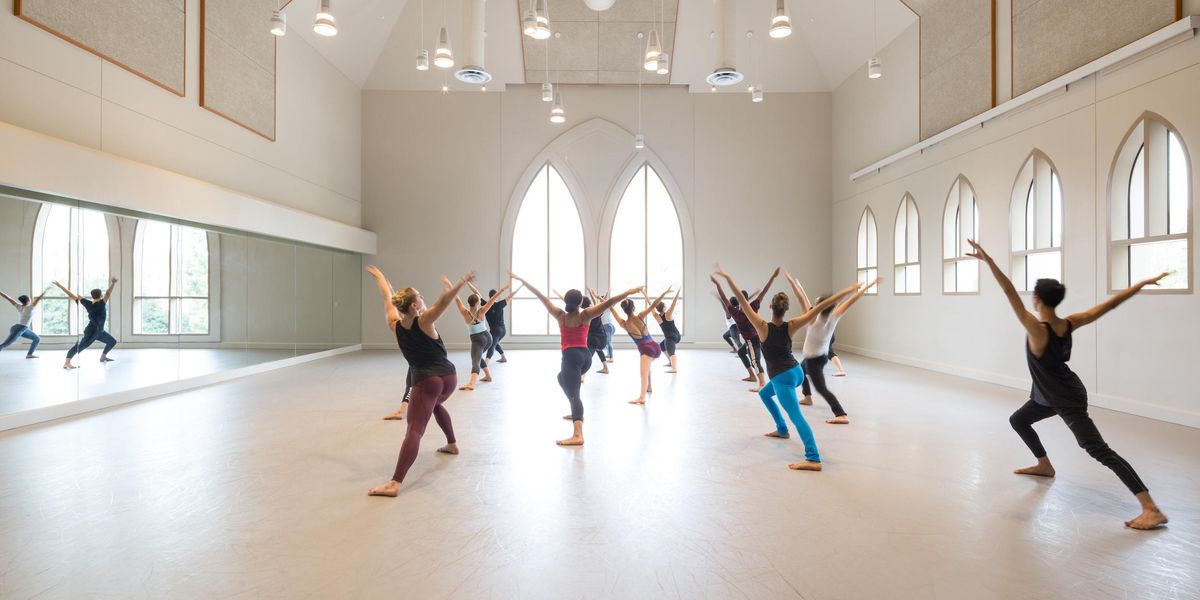Centerwork: Brief Visit, Lasting Impact
The rewards of working with college artists-in-residence
UIUC students (including Sanda Saveanu, far right) in Trisha Brown’s
Astral Convertible (Re-imagined). Photo by Valerie Oliveiro, Courtesy UIUC.
Artist-in-residence programs have become a staple of a first-class university dance education. During four years with the same faculty, the temporary presence of a new teaching voice can bring out capabilities in students that may have otherwise gone unstirred. Visiting artists—whether choreographers themselves, or members of a renowned choreographer’s company—connect students to the dance world beyond campus walls, while inviting them to discover new ways of thinking, creating, and moving. At their best, artist-in-residence programs foster relationships between students and choreographers that can blossom into future dance careers. Dance Magazine spoke with students and alumni of three universities about working with guest artists who helped shape them into the dancers they are today.
From Campus to Company
Rita Donahue, a member of the Mark Morris Dance Group, graduated from George Mason University in 2002. She joined MMDG—whose dancers are frequently in residence at the university—less than a year later. “I had a lot of really wonderful connections with Mark Morris before I ever even danced for him,” she says. She first met him when Rachel Murray (then a dancer with MMDG) came to GMU to set Morris’ Marble Halls. During Murray’s residency, Morris himself visited to run rehearsals. “It was really inspiring to have the man himself come in and take the time to tell us what we were doing right or wrong,” Donahue says. Morris’ love of music stood out to Donahue even as a student. “He was thrilled that we were going to perform with the student orchestra,” she remembers.
As a student at GMU, which is located in Fairfax, Virginia, Donahue also worked with retiring MMDG member Kraig Patterson, who was in residence setting his own work. Donahue saw Patterson again at various summer programs and eventually worked with him when she first arrived in New York after graduation. “Even if you’re not working with the choreographer himself, you’re exposed to people who have been around them, so they share the same ideas,” she says. “It lets you as the student know whether you’re interested in doing that kind of work at another level.”
Lingering lessons
Sanda Saveanu was feeling particularly nervous as she took to the stage to rehearse Trisha Brown’s Astral Convertible—because Brown was in the audience. “It was one of the few times that I’ve gotten to meet a choreographer whose works I’ve seen onstage,” recalls Saveanu, who was then a sophomore at the University of Illinois–Urbana-Champaign. While Brown’s choice of dress may have suggested otherwise (leopard-print leggings and a bright sweater), Saveanu found her to be remarkably down-to-earth, with an air of support for the dancers.
Brown’s visit was the grand finale to a five-week residency at UIUC (divided up over a few months) by one of the iconic choreographer’s former dancers, Kathleen Fisher. Once a group of students had been selected through an audition, they worked with Fisher for about four hours a day learning Astral and studying Brown’s fluid yet specific style. The impact of the experience on Saveanu, who is now a senior, has been lasting. “I still feel affected by that movement,” she says. “I feel like I understand it more now than when I was in the piece.”
Coming Full Circle
When Seán Curran walked into the studio at Roger Williams University in his cowboy boots and thick mustache during Christina Robson’s senior year, he brought with him an energy she wanted instantly to be part of. “I’m really drawn to the geometry of his work,” Robson says. “There’s a lot of focus on geometry both with the body and throughout space, but with that clarity, he also wants the rigor of raw physicality.” As a student used to adapting to the stylistic whims of a choreographer, she found that “being herself” was the greatest challenge in Curran’s work. “I can just see him running around in those cowboy boots,” she laughs, “yelling, ‘Come on, put some Christina in it!’ ”
At the end of his weeklong residency on the Bristol, Rhode Island campus, Curran took time to ask the senior students what their plans were for the future. He asked Robson if she was considering moving to New York. When she expressed hesitation, Curran invited her to participate in his rehearsal process for a couple of weeks to see if she might enjoy it. “I hopped on a bus with a backpack and stayed in a hostel for two weeks,” she says. “Those were seriously the best two weeks of my life. It’s cheesy, but I felt like it was my dream actualized.” After the trial period, Curran offered her a position in his company.
Last fall, Robson joined Curran for his most recent residency at RWU, where the two spent a week working intensively with a group of students. “That’s when he’s happiest I think, when he’s teaching,” she says. “He definitely brings a huge joy and energy to student life, and it’s really inspiring for students to express themselves through his work as a vehicle.”
Kathleen McGuire is a dance writer based in Pittsburgh, PA.




